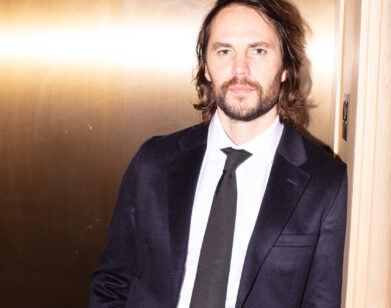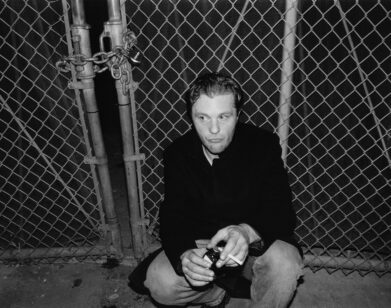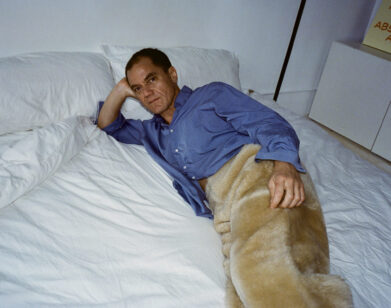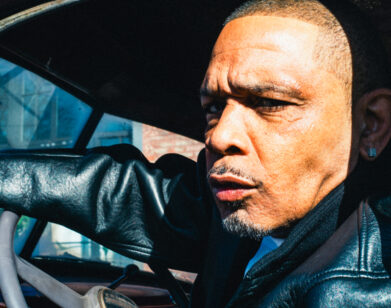Pedro Almodóvar, The Meticulously Controlled Craftsman

Pedro Almodóvar is known for his messy, frenetic, kaleidoscopic visions. But the Spanish director himself is in fact a meticulously controlled craftsman—more classical portrait painter than abstract expressionist. His latest film, Broken Embraces (Los Abrazos Rotos), is a prime example: a painstakingly constructed work that simultaneously functions as a tribute to noir, cinema, the professions of writing and directing, the art of having grand passions, and of course, his frequent star (and our cover subject) Penélope Cruz. The Chinese-box plot involves a blind filmmaker (Lluís Homar) who some 14 years -earlier lost his sight after making what would be his last movie. Holed up in his apartment while being cared for by his former production manager (Blanca Portillo) and her son (Tamar Novas), he tells the story of how he fell in love with a powerful businessman’s mistress (Cruz), gave up his film for her, and eventually lost it all. In typical Almodóvar form, Broken Embraces also involves a film being made within the film—called Girls and Suitcases, eerily reminiscent of Almodóvar’s own Women on the Verge of a Nervous Breakdown (1988)—as well as a making-of documentary, which gets everyone in trouble. On a recent trip to New York City, the 60-year-old Almodóvar spoke with fellow filmmaker Paul Thomas Anderson.
PAUL THOMAS ANDERSON: What are you doing in New York right now?
PEDRO ALMODÓVAR: I’m workshopping a stage version of Women on the Verge of a Nervous Breakdown, which is going to be a musical on Broadway.
ANDERSON: Really? Who’s doing that?
ALMODÓVAR: Bartlett Sher is the director. I saw his version of South Pacific and found it wonderful. Anyway, they are consulting me a lot, so it is very interesting. Have you ever directed a play?
ANDERSON: No. Have you?
ALMODÓVAR: No, so for me this is like a class. But I identify a lot with the workshop because it’s similar to the way I rehearse in making my movies. Before shooting, I prepare with the actors much more like it’s a theater play than a movie. Apparently that way of working is very unusual. Do you do that?
ANDERSON: It’s different every time. It depends on the actor. With Daniel Day-Lewis on There Will Be Blood [2007], we talked about everything except the movie for the longest time. We talked on the phone—I was in California, and he was in Ireland. We would talk about the weather, sports, our families, and then, right at the end of our conversation, we’d talk a bit about the movie. This went on for maybe a year.
ALMODÓVAR: It does depend on the actors. With Penélope [Cruz], for example, who I used in my last two films, we rehearsed the voice for at least two months before shooting.ANDERSON: I want to talk about Penélope. She’s always been a wonderful actress, but something seems to have happened over the past few years. With her performance in Volver [2006] and now in Broken Embraces, it almost seems as if she’s grown into her beauty and is in this absolute sweet spot in terms of her performances. Have you seen her change and grow over the last few films?
ALMODÓVAR: Penélope really has been growingbefore the gaze of the American public and the directors. But if you think of her from the very beginning, from a film like Jamón, Jamón [1992], she already had a lot of those qualities. Perhaps they weren’t expressed quite as they are now, but they were there from the beginning. She has a very sincere kind of emotionalism that connects her with her gut. She’s a warrior, a survivor, someone who can overcome—that’s a quality that’s very strong in her. And then, at the same time, she has this almost childlike vulnerability.
A look back at the films of Pedro Almodóvar:
ANDERSON: Do you think you’re going to keep working together? Because I keep getting the feeling that you’re both at a point in your work where it’s a perfect marriage right now.
ALMODÓVAR: I will definitely keep working with her. I’m not sure exactly when we’ll do it again. I’m presently working on two stories that are well developed, but I still don’t have the characters very well visualized, so I don’t know whether she’ll be in these. But I do have that feeling that we’ve formed a kind of marriage. The media treats us as such. The tone of Broken Embraces is very different. Penélope is very beautiful and just radiates, so I had to take away some of that radiance and make her as dark as possible. In this particular role, she really has to access things that aren’t part of her experience because the role is really for someone a little bit older and who has had a much harder past. So she’s been able to do it exclusively through her discipline and her faith in me.
ANDERSON: When an actor does a wonderful take, are you able to fight the instinct to ask them to do it again and again? Are you able to walk away with the joy that you’ve gotten it and say, “We did it. That’s good enough,” or do you get greedy for more?
ALMODÓVAR: With Penélope, I always ask for more. It doesn’t happen with every actor—some actors I get in the first, second, or third take. But I get Penélope in the tenth take. The more you work with her, the better she gets. I might be perfectly satisfied with the fourth take, but because I know Penélope, I know if I keep pushing, she will be even more marvelous on the tenth.
ANDERSON: There’s a line in Broken Embraces when the main character, Harry Caine, says, “I was a story-teller before I was a filmmaker.” I thought that line was funny because it’s as if he’s beating himself up about being a filmmaker, that he was somehow happier as a storyteller.
ALMODÓVAR: It’s very curious that you mention that line because it is absolutely based on my experience. I was always storytelling, since I was a child.
I remember myself at 10 years old telling stories to my sisters and brother. This is something I did through my adolescence and even through my twenties. So, yes, of course, I always enjoyed telling stories. I mean, if I had not been successful as a director, then I’m sure I would still be telling stories. I would have continued on 16mm or found a different medium through which to tell them. Maybe they would have been less glamorous than films, but I would continue to tell stories.
ANDERSON: There’s another moment that struck me in Broken Embraces, when Penélope’s character is talking to Harry Caine. He has taken a photograph of a couple on the beach, and she asks him what is happening with the couple, what is their secret. He says, “I don’t know. I have to write it to find out.” Is that a good reflection on how you start a story?
ALMODÓVAR: It’s curious that you mention this scene too, because again, I’m talking about myself. When I start writing, the first line might come from reality, but the second and the third one, I have to write it. So this is the genesis of my creation. If I want to know what happens, if I want to find out the secret, I have to write it.
ANDERSON: When you begin, do you know you are setting out to tell a ghost story or a noir story or a love story? Do you have a genre in mind?
ALMODÓVAR: The way I start is that I write about 10 pages—kind of a synopsis on some level. The problem is that I work in more than one genre. It’s impossible for me to aim for a single one because, for me, comedy is mixed with tragedy. That’s very Spanish, the way in which comedy and tragedy are inextricable from each other. But in those 10 pages, the tone is there. Usually, what I write at first is the middle of the story, and I think, Oh, I am interested in this character. But to know how this character got to this particular situation, I then have to write the past of the character, then the future. It’s not even conscious.
ANDERSON: I know just what you mean. I’ve been thinking lately that writing sometimes becomes more about weight distribution.
ALMODÓVAR: [laughs] This is the balance you have to make when you are writing.
ANDERSON: And your films are always bursting with stories, not just the story. In Broken Embraces, there is also the film that is being made in this film called Girls and Suitcases. And then there’s the Give Your Blood film synopsis that Harry Caine and Diego discuss, which could be its own film.
ALMODÓVAR: But this is also the signification of my work. There is always a glorification of telling stories. Never is there only one story. There are many stories around that I also like to tell. This can be a bit of a problem. The script can sin from getting too inflated with stories, and you have to control that. So let’s say that, in the last 20 years, what I was trying to control in myself was not putting up too many stories, but actually deciding which is the main one. AndI think I can be more concentrated now. But for Broken Embraces—I don’t know if I dare to say—this film is really a reflection of my work, my profession, and also the relation that I have with cinema. In fact, it’s a declaration of my love for cinema. After doing this movie, I saw that, for me, cinema was almost more important than life. Or rather, film actually perfects life. The characters, for example, are really undergoing a terrible tragedy, but the film also works perfectly well as a comedy. The presence of all of these stories is one of the themes of this film, because everything that surrounds cinema is expressive. And everything that surrounds the making of a film tells a different story than the film itself.
ANDERSON: The entire film leads to something that happens that is a director’s worst nightmare: essentially, the idea of not being able to finish your own film.
ALMODÓVAR: This is one of the themes.ANDERSON: Even though it doesn’t result from choice, there is a sense that Harry Caine could only have one or the other—he could have his love or he could have his film. In the end, it’s an unfinished love and an unfinished film. So I like this idea that he has a second chance to finish the film.
ALMODÓVAR: The last words that the main character says are very important: “You have to finish a movie even if you’re blind.” It’s very dangerous that someone comes between all the material that’s been shot and the creator of the material who shot it. In that way, I’m also defending the integrity of films at the moment at which they’re made. That’s a call to American directors to have the final word in the editing room. It means that you not only have to edit your own material, but also that you have to respect the author of the material. It is a moral question. In Europe, it is very simple: We all understand who the moral author of the movie is. In Spain, it’s the director and the screenwriter. But in Hollywood, it’s the producer. Whereas in Europe, it’s the author of the film who retains the moral authority. For me, this is all part of the integrity of the movies. This is very important. Fortunately, it seems to me that you were the full owner of the five movies that you made. You can say that they all belong to you.
ANDERSON: They all belong to me. The very first film, I had to fight to finish. It was baptism by fire. I learned all the lessons I needed to learn on the first film, about protecting myself and how to keep a lock on the editing-room door. What’s interesting is that in Broken Embraces, you see Harry Caine editing Girls and Suitcases on the Avid. Then it’s 14 years later, and you see that everything’s digital.
ALMODÓVAR: I was very interested in showing this. I’m not necessarily a fetishistic man, but I do feel some nostalgia for the Moviola. My first 16 films were all edited on the Moviola, so for me it’s on the Moviola that you really create the narrative.
ANDERSON: There isn’t the same beauty when you see a mouse click and drag something onto a screen.
ALMODÓVAR: Not at all—no, no, no.
ANDERSON: I want to tell you my favorite scene in Broken Embraces: It’s when Penélope is pushed down the stairs.
ALMODÓVAR: Sí, sí. [laughs] I like it also very much. I used four cameras at the same time, at different angles, just to make it very rhythmic. But I decided to use only one take. One of my favorite moments in that scene is also when Penélope is already at the bottom of the stairs. She’s crawling—almost as if she were a reptile—trying to get away from him.
Photo: Pedro Almodóvar in New York, June 2009. Jacket: Moschino Uomo. Grooming Products: Shu Uemura Art of Hair, including silk mesh elastic moldable cream. Styling: Ayako Yoshida. Grooming: Ryoji Imaizumi/ Marek and Associates. Set Design: Peter Mayer. Special Thanks: Pier 59 Studios.
Paul Thomas Anderson is an Academy Award–nominated screenwriter and director.
Read Interview’s cover story on Penelope Cruz.






